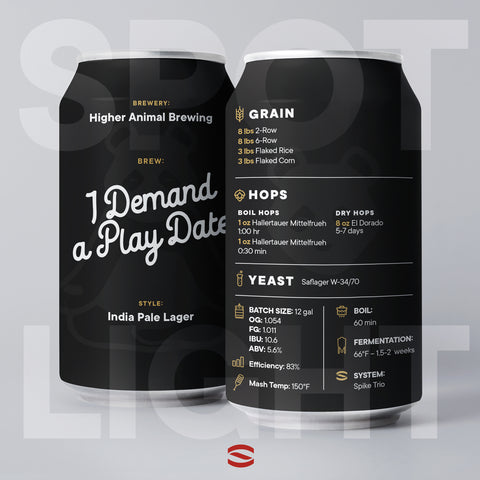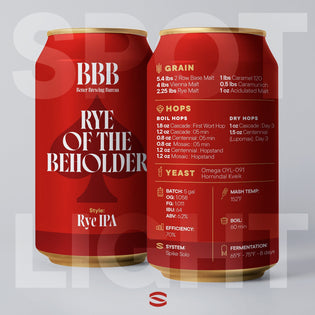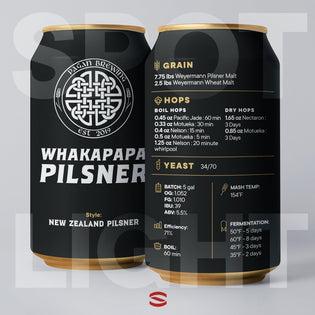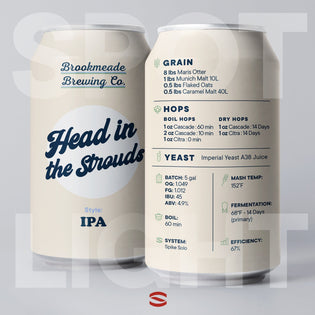
The Brewers: Higher Animal Brewing
We discovered that we all had the same passion, vision and direction for opening a taproom and as they say…the rest is history. Higher Animal plans to open a cool, chill space to hang out with your friends and enjoy a great beer in 2023.

We absolutely love the control you get from the Trio and CF15’s. From the locked in mash temps to the locked in fermentation temps, the versatility we have is unmatched. The possibilities are only bound by your creativity.
The Beer: India Pale Lager
This is our summer crusher and pool beer. For this one, we like to K.I.S.S. (keep it simple, stupid).
The name ‘I Demand a Playdate’ comes from a conversation between Jason’s daughter, Willa, and one of her best friend’s dad. Willa saw Nate and demanded a playdate with Scout. He replied, “I only take demands on the 31st of the month.” Three years later, she still calls Nate on the 31st of each month and proclaims, “I demand a play date!”

It's a basic 1.33 liquor to grist ratio. So, for 7.5 gallons of strike water, we add 7 grams of calcium chloride and 5 grams of gypsum as our water profile. Mash in normally.
The Recipe: I Demand a Playdate

INGREDIENTS
GRAIN
- 8 lbs 2-Row
- 8 lbs 6-Row
- 3 lbs Flaked Rice
- 3 lbs Flaked Corn
HOPS
- Boil hops: 1 oz Hallertauer Mittelfruh - 1:00 hr
- Boil hops: 1 oz Hallertauer Mittelfruh - 0:30 min
- Dry hops: 8 oz El Dorado - 5-7 days
YEAST
- Saflager W-34/70

INSTRUCTIONS
BATCH SIZE: 12 gal
OG: 1.054
FG: 1.011
IBU: 10.6
ABV: 5.6%
EFFICIENCY: 83%
MASH TEMP: 150ºF
BOIL: 60 min
FERMENTATION: 66ºF - 1.5-2 weeks
SYSTEM: Trio
Pro Tips
1. The flaked grain should be separate from the 2-row and 6-row. Don't crush the flaked grains and just layer them on top of the mash after mash-in.
2. If you haven't ever tried fermenting 34/70 at ale temps, hold onto your reigns because this beer will ferment out in about 4 days total. With this being said, we add our dry hops on day 2.
3. After fermentation is complete, we wait 3-5 days so the yeast can do it's clean-up duties and then we crash & carb, add finings if desired, and keg. We are grain to glass in a little under 2 weeks or so.
4. It’s very important to maintain that 66* fermentation temp because if you increase it towards 70*, it tends to dry this beer out more than we like.
5. You can play around with the dry hop to showcase any other hop you'd like, as well (Citra, Mosaic, ect.). If you are just brewing 6 gallons, just split everything in half. Oh ya, one more thing...have fun and happy brewing!

Cheers,
Jason, Don and Chad from Higher Animal Brewing
Spike Summarizes: All About India Pale Lagers
What is an India Pale Lager (IPL)?
An India Pale Lager (IPL) is a hybrid beer style that brings together the best of two beer worlds – the hop-forward attributes of an India Pale Ale (IPA) and the smooth, clean crispness of a lager.
Originating in the early 21st century, the IPL is a contemporary beer style that has made a name for itself through its unique and complex flavor profile.
What distinguishes IPL from other beers?
The key differentiating factor for an IPL lies in its balance between robust hop flavors and a smooth lager finish, a combination not commonly found in other beer styles.
The Fermentation Process
The brewing process also sets IPL apart. Despite using ingredients similar to an IPA, it follows the lagering process, a method of fermentation and conditioning at cooler temperatures.
What's the history of IPL?
IPL is a fairly new beer style, emerging from the American craft beer scene in the early 2000s as brewers sought innovative ways to experiment with beer flavors.
The India Pale Ale Influence
The origins of IPL can be traced back to the popularity of IPA and the brewer's quest to infuse its hoppiness into a lighter, more crisp beer - hence, the birth of IPL.
What does an IPL taste like?
With an IPL, expect a symphony of flavors. The beer typically starts with a strong hop bitterness, reminiscent of an IPA, boasting flavors of pine, citrus, or even tropical fruit.
The flavor then transitions into the smooth, clean malt profile typical of a lager, often leaving a crisp finish that lingers.
How is IPL made?
Like an IPA, IPL uses hops generously, but it is brewed with lager yeast and fermented at cooler temperatures, akin to a traditional lager.
The process involves primary fermentation at lower temperatures, followed by an extended period of cold conditioning, or "lagering," which aids in enhancing the beer’s clarity and crispness.
What are the essential ingredients in an IPL?
Power of Hops
In an IPL, hops are key. Brewers often use varieties that impart bold flavors and aromas, such as citrus, pine, floral, or tropical fruit notes.
Yeast and Malt
Lager yeast and a balanced malt base, which might include pilsner malt, Vienna malt, or Munich malt, are also essential in crafting an IPL.
Is IPL a year-round beer?
Yes, IPL can be enjoyed year-round. Its light, crisp lager characteristics make it a refreshing option for warmer months, while the hop-forward flavors provide a satisfying complexity for colder seasons.
How strong is a typical IPL?
IPLs generally have an alcohol by volume (ABV) in the range of 5.5% to 7%, although some versions may go higher. Despite their strength, IPLs typically maintain a balanced, accessible profile.
Are there different types of IPL beers?
As IPL is a style born from the craft beer movement, there are many variations. Some brewers may choose to use different hop varieties, imparting a unique character to their version of IPL.
What's the correct temperature for serving IPL?
IPLs are best served at "cellar temperature," around 50 to 55 degrees Fahrenheit (10-13 degrees Celsius). This temperature range allows both the hop flavors and the smooth lager characteristics to shine.
What are some popular brands of IPL?
Several craft breweries have gained recognition for their IPLs. Examples include Jack’s Abby Brewing's "Hoponius Union" and Ballast Point's "Fathom IPL."
Why does IPL have a golden color?
The golden color of an IPL largely comes from the malt used during brewing. Pale malts often used in IPL production lend a light to medium golden hue to the beer.
How does the brewing process affect IPL's flavor?
The lager fermentation process, along with the cooler fermentation temperatures, allows for a clean, crisp beer that highlights the chosen hops' flavors and aromas, contributing to the beer's overall complexity.
Is an IPL a bitter beer?
Due to the generous use of hops, IPLs can be quite bitter. However, this bitterness is balanced by the smooth, malty characteristics brought about by the lagering process.
Why is IPL often served in a specific type of glass?
A glass with a stem and a tulip-shaped top, like a Belgian beer glass, is often used to serve IPL. This type of glass helps maintain the beer's temperature, enhances its aroma, and supports a frothy head.
Is IPL beer good for beginners?
IPL can be a great choice for beer beginners open to trying a beer with complex flavors. It combines the hoppy punch of an IPA with the easy-drinking nature of a lager, offering an intriguing introduction to the world of craft beer.
How does American IPL differ from other IPLs?
American IPLs often feature American hop varieties known for their bold, often citrusy and piney flavors. The use of these hops can impart a distinct character compared to IPLs made with European or other hop varieties.
Where can I buy the best IPL beers?
IPL beers can be found at craft breweries, specialty beer stores, and online beer retailers. As the style becomes more popular, it’s also increasingly found in local supermarkets and liquor stores. Always remember to check for freshness to ensure the best flavor.
What factors influenced the development of IPL?
Craft Beer Boom
The emergence of IPL was strongly influenced by the craft beer revolution, where innovation and experimentation became central to brewing. Brewers sought to create unique styles that stood out in an increasingly competitive market.
Hop Appreciation
The rise in popularity of hop-forward beers, particularly IPAs, also played a crucial role. Brewers saw an opportunity to combine the hoppiness of IPAs with the smoothness of lagers, thus creating a new hybrid style.
Why is the fermentation temperature critical in making IPL?
Yeast Performance
The fermentation temperature is crucial because lager yeast strains used in IPL production perform best at cooler temperatures, typically between 45-55°F (7-13°C). This promotes clean fermentation, reducing fruity esters and spicy phenols, thereby allowing the hops to take center stage.
Lagering Effect
The lower fermentation temperature also enables a process known as lagering. This extended, cold storage period helps to enhance the beer's clarity, stability, and smoothness, characteristics intrinsic to the IPL style.
How has the IPL style been received by the beer community?
The IPL style has been enthusiastically received, particularly among craft beer aficionados. It's often celebrated for its unique blending of styles and has become a symbol of the innovative spirit within the craft beer community.
Additionally, IPL has broad appeal due to its balanced nature. It appeals to IPA lovers seeking something different, lager drinkers looking for a flavor boost, and newcomers seeking a complex but approachable beer style.
Does IPL age well?
As with most hop-forward beers, IPLs are generally best consumed fresh. Over time, the hop flavors and aromas will diminish, and the beer may develop off-flavors. To enjoy an IPL at its best, it's recommended to consume it within a few months of packaging.
What glassware is best for enjoying an IPL?
Choosing the right glass can enhance the IPL drinking experience. A glass that tapers at the top, such as a tulip glass or even an IPA glass, is an excellent choice. These glasses concentrate the hop aromas and help maintain a nice head, amplifying the sensory experience of the IPL.
What makes IPLs so versatile with food?
The balance of hop bitterness and smooth lager qualities makes IPL a versatile pairing option. The hop bitterness can cut through rich, fatty foods or balance spicy dishes, while the crisp lager finish refreshes the palate.
What's the future of IPL?
As interest in craft beer and unique styles continues to grow, the future looks promising for IPL. Brewers are likely to continue experimenting with this style, and we can expect to see an increasing variety of IPLs on the market.
Given its balanced nature, IPL has the potential to bridge the gap between traditional lagers and more robust, hop-forward beers, thus broadening its appeal among different beer drinkers.
How can homebrewers brew their own IPL?
Homebrewing an IPL can be a fun challenge for beer enthusiasts looking to explore this unique style. The process generally involves using a generous amount of hops, similar to an IPA recipe, but fermenting with lager yeast at cooler temperatures.
Focus on Fermentation
The key to brewing a successful IPL at home is nailing the fermentation process. Lager yeast requires a controlled environment and stable, cool temperatures. Therefore, homebrewers need to have a set-up that allows them to maintain these conditions throughout fermentation and lagering.
Are there any beer festivals or events that feature IPLs?
IPLs, being a product of the craft beer movement, are often featured in craft beer festivals. Events like the Great American Beer Festival, Craft Brewers Conference, and local craft beer festivals are excellent places to explore a range of IPLs.
Can IPLs be barrel-aged?
While IPL is typically enjoyed fresh to maintain its hoppy characteristics, some brewers experiment with barrel-aging IPLs. Barrel aging can add another layer of complexity, infusing the beer with flavors from the barrel, such as vanilla, oak, or even bourbon.
However, it's important to note that barrel-aged IPLs will be quite different from fresh ones. The hoppy punch will be more subdued, making way for the flavors imparted by the barrel.
Is it common for IPLs to have added flavorings?
While traditional IPLs rely on the interplay of hops, malt, and yeast for their flavor, some brewers do experiment with added flavorings. This could include ingredients such as fruit, spices, or coffee. The aim is often to complement the hop profile and add an extra dimension to the beer.
How important is water quality in brewing IPL?
Water quality is crucial in brewing all beer styles, including IPL. The mineral content of the water can influence the beer's flavor and the effectiveness of the brewing process. For IPL, brewers often use water profiles that enhance the hop bitterness while ensuring a smooth finish.
What is the shelf life of an IPL?
As mentioned earlier, IPLs are best consumed fresh, ideally within a few months of packaging. This ensures that the hop aroma and flavor are at their peak. Over time, these qualities diminish, and the beer may lose some of its distinctive IPL characteristics.
What are some tips for serving IPL?
Serving IPL at the correct temperature, typically between 50-55°F (10-13°C), is crucial to fully appreciate its complex flavor profile. Serving it too cold can suppress the hop character and malt balance.
The Pour
Pouring IPL correctly is also key. Aim for a moderate pour that forms a decent head, which helps release the beer's aromas. If served from a bottle or can, don't pour out the entire contents in one go. Leave a little behind initially, swirl it around to capture any sediment and flavor, then pour the rest.
Are there certain seasons where IPLs are more popular?
While IPLs can be enjoyed year-round, they tend to be particularly popular during the transitions between seasons. Their complex profile, combining the refreshing qualities of a lager with the flavorful hop character of an IPA, makes them an excellent choice for both warm and cool weather.
What impact does the choice of malt have on an IPL?
The choice of malt in an IPL is crucial in achieving a balance between the strong hop flavors and the smooth lager finish. Malt provides the sweetness that counteracts the hop bitterness and contributes to the body and color of the beer.
Pilsner malt is commonly used due to its light flavor and color, which allows the hops to shine. However, some brewers may choose to incorporate Vienna or Munich malts to add a bit more maltiness and complexity.
How long does the lagering process typically take for an IPL?
The lagering process for an IPL typically takes several weeks, but it can sometimes extend up to several months. The exact duration depends on the specific recipe and the brewer's preference. The extended lagering period helps to enhance the beer’s clarity and crispness, essential characteristics of the IPL style.
What's the difference between dry-hopped and traditionally hopped IPL?
Traditional vs. Dry Hopping
Traditional hopping involves adding hops during the boil, which contributes to the beer's bitterness. On the other hand, dry hopping involves adding hops post-boil or during fermentation. This method imparts more aroma and flavor, without significantly increasing bitterness.
Impact on IPL
In the context of IPL, both methods are typically used. Traditional hopping provides the base bitterness while dry hopping enhances the hop-forward character that distinguishes IPLs. Some IPLs might be more heavily dry-hopped, leading to a more pronounced aroma and hop flavor.
Are IPLs usually bottle-conditioned?
While IPLs are not typically bottle-conditioned (a process where sugar and yeast are added before bottling to create natural carbonation), some breweries might choose this method. Bottle conditioning can add an extra layer of complexity to the beer, but it also requires more time and careful handling.
Can the water profile impact the taste of IPL?
Absolutely, the water profile can significantly impact the taste of an IPL. Different mineral compositions in the water can accentuate or diminish the impact of the hops, alter the perceived bitterness, and influence the mouthfeel. As such, brewers often carefully adjust their water profile when brewing IPL to achieve their desired flavor outcome. For more on water chemistry and brewing, check out this latest blog, It’s a Wonderful Waterworld: Your Go-To Guide for Water Chemistry and ph in Brewing.





